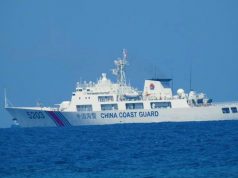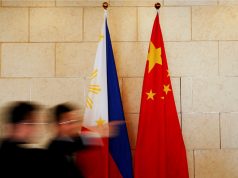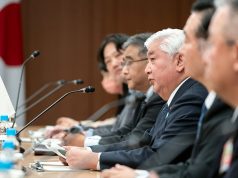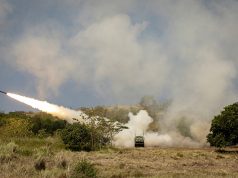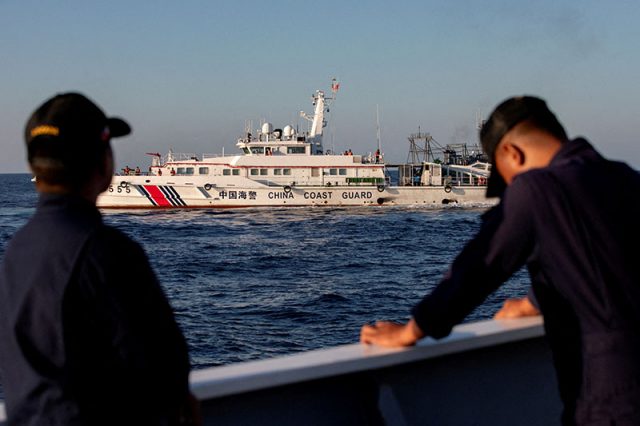
The opinions expressed here are those of the author, a columnist for Reuters.
LONDON — As the largest vessel in the Philippines Coast Guard returned to port last week after five months blockaded by Chinese patrol vessels and fishing craft at the disputed Sabina Shoal in the South China Sea, ambulances waited on the quayside to receive several crew members, two carried off by stretcher.
Officials in the Philippines have steadfastly refused to describe their decision to withdraw the BRP Teresa Magbanua as any kind of defeat, vowing to send a new patrol ship to the shoal “immediately”.
But they have not been reported to have done so yet, and as details emerge of conditions aboard the Teresa Magbanua on her most recent mission, it is far from clear that they will be able to.
In the past, Chinese officials talked of a “cabbage strategy” to drive the Philippines and other rivals from disputed reefs and islands, surrounding them “like a cabbage” with so many Chinese patrol craft, fishing boats and other vessels that supplies cannot be delivered.
During the Cold War, Western officials used another phrase – “salami tactics” – to describe the Soviet Union taking what it wanted “slice by slice,” an approach they believed needed to be confronted with an occasional dramatic display of Western resolve.
Such a move has been under discussion for months in the Philippines. But as with Ukraine on the other side of the world, the U.S. and its allies face adversaries who believe time is on their side.
Some U.S. officials reject the formulation, pointing to China’s deteriorating demographics and Russia’s war-damaged economy to suggest both are also themselves running out of time – but worry that might spur more dangerous decision-making, particularly if the U.S. and allies look to be retreating.
In August, the head of the U.S. Indo Pacific Command Admiral, Samuel Paparo, said that under the terms of a 1951 U.S.-Philippines mutual defense treaty, it would be “entirely reasonable” for U.S. forces to escort their Philippine allies on resupply missions.
Philippines Chief of Staff General Romeo Brawner had said earlier in the year that his government preferred to conduct such operations alone, but might turn to the United States once all other options were exhausted.
“When our troops are already hungry, they don’t have supplies anymore because our resupply missions have been blocked and they are on the verge of dying, then that’s the time that we are going to seek the help of the United States,” Brawner told reporters in July.
But in reality the Philippines this month appeared to choose withdrawal over pursuing such an option, even as officials have given interviews to U.S. media decrying China as a “schoolyard bully”.
On Aug. 26, authorities in the Philippines say 40 Chinese vessels and warships prevented two Filipino vessels from resupplying the Magbanua. While a helicopter was used to deliver some supplies on Aug. 29, it was not enough to feed the crew – the ship’s standard company is almost 70 – nor fix broken desalination equipment.
According to the Philippines Coast Guard, in their last weeks aboard the ship, the crew were dependent on porridge and rainwater, sometimes forced to distil and boil water from the air conditioning system when there was no rain. The ship also needed repairs after being rammed by at least two Chinese vessels on Aug. 31, they said.
Photos taken by both the Philippines and China showed two tugs amongst the multiple other Chinese vessels, prompting speculation that if the Philippine vessel did not leave, the Chinese might attempt to tow it away, a humiliation the Manila government must have wanted to avoid.
Cold war lessons from Berlin
Beijing claims almost the entire South China Sea as its “historic waters” and has continued to build up outposts and increased maritime activity, despite a 2016 United Nations maritime court ruling that described most of the Spratly Islands – including the disputed Sabina and Second Thomas shoals – as part of the Philippines Exclusive Economic Zone.
Chinese officials and media welcomed the withdrawal of the Magbanua – which they described as “illegally anchored”, and therefore subjected to official Chinese “control measures”– with its departure following a direct bilateral meeting between Chinese officials and those from the Philippines. The contents of those discussions have not been released by either side.
Under a 2002 agreement signed by members of the Association of South East Asian Nations, countries including China and the Philippines committed not to build new installations on shoals uninhabited at that point, designed to stop the building of encampments or stranding of vessels such as that by China at Mischief Reef in 1996 and the Philippines at Second Thomas Shoal in 1999.
Since then, however, Beijing has continued to step up its pressure on the handful of tiny islands that house small Filipino military detachments. In 2012, Chinese patrol vessels and those from the Philippines were involved in a two-month face-off at another disputed reef, Scarborough Shoal. Under a U.S.-brokered deal, both sides promised to withdraw – but in fact, the Chinese side remained.
The phrase “salami tactics” likely originated with U.S. diplomat Allan E. Lightner, Deputy Chief of Mission at the U.S. embassy in Berlin in August 1961. As Soviet and East German troops built the Berlin wall to enclose the Soviet-controlled east of the city, he suggested it was likely a precursor to cutting off the whole of U.S., British and French-administered West Berlin itself.
“Having taken such a big slice of salami and successfully digested it, with no hindrance, they may be expected to snatch further pieces greedily,” he wrote in a cable to Washington. “Their success will encourage … further steps.” He recommended decisive and rapid U.S. action.
US military choices
U.S. President John F. Kennedy shared that diagnosis. Three days after Lightner’s message, he ordered a U.S. battle group to reinforce West Berlin, driving up the sealed motorway the next day through East Germany as permitted by the Potsdam treaty. If the Soviets attempted to stop them, wider war seemed certain. It was one of the tensest Cold War moments, jumpy U.S. troops in full battle rig waiting to be blocked or confronted by East Germany or the Soviets.
There are some in Washington who would like to do something similarly punchy to reinforce the Philippines – and fear that if China continues to push Manila back, Beijing may feel more confident to use excessive force elsewhere, most notably against Taiwan.
U.S. officials say they believe Chinese President Xi Jinping has instructed his military to be ready to invade Taiwan, which China considers a rogue province, by 2027 but has not yet made a decision on whether or not to do so.
U.S. and Taiwanese officials, who strongly object to China’s sovereignty claims and say only the island’s people can decide their future, also fear a blockade aimed at stripping Taiwan of foreign support and trade – something the U.S. would have to either have to break or allow Taiwan to fall.
Deterring Chinese action against Taiwan and more South China Sea adventurism will be high on the U.S. agenda as it resumes military-to-military dialogue with Beijing following National Security Adviser Jake Sullivan’s visit to China last month, in which he met Xi and other top officials.
Since then, U.S. Indo-Pacific Command chief Paparo has had a video call with China’s Southern Theatre Command head General Wu Yunan, who the Financial Times reported will also visit Paparo’s headquarters in Hawaii later this month. Michael Chase, the top Pentagon official for China policy, was also reported visiting Beijing to meet his Chinese counterparts.
The key challenge, as in the Ukraine war, is time. Beijing has already put more than three decades effort into building its posture in the South China Sea, and more than twice that into building up pressure on Taiwan.
Russia, which Western powers say is now receiving weapons from North Korea and Iran – a charge those countries deny – appears to have the resources to outgun the Kyiv government in the longer term and keep pushing forward on the battlefield.
“It is a kind of tyranny of time,” Pavlo Palisa, commander of Ukraine’s 93rd Separate Mechanized Brigade fighting in the east, told a conference in Kyiv this week. “At the beginning we hoped it would not be too long. Now we realise it will take much more time than we expected.”
For Washington, therein lies the challenge. Russian and Chinese propagandists frequently point to the example of Afghanistan, warning America’s allies in Taiwan, the Philippines, Ukraine and Eastern Europe that they too will one day be abandoned – and therefore they might as well yield now.
The next U.S. president may need to look as though the United States and allies can outlast Moscow and Beijing in all those confrontations.
If they cannot, an ageing Xi and Russian President Vladimir Putin – and those who wish to follow them – may be tempted to take ever-greater gambles.
—By Peter Apps; Editing by Conor Humphries




